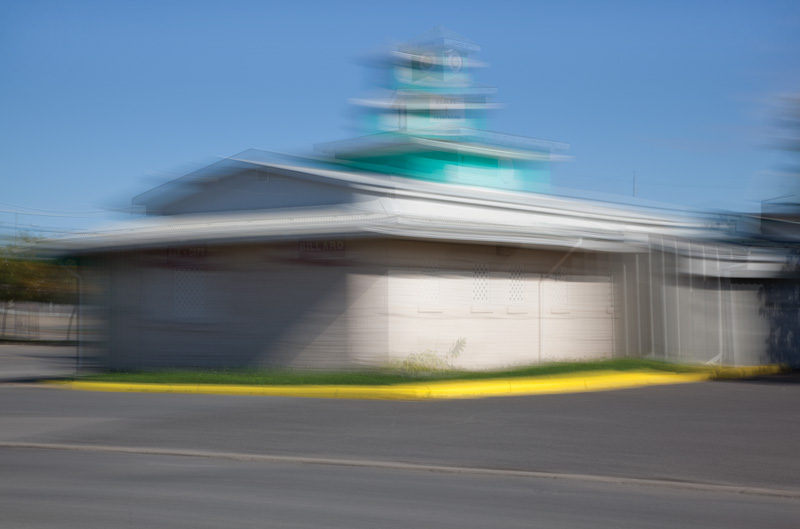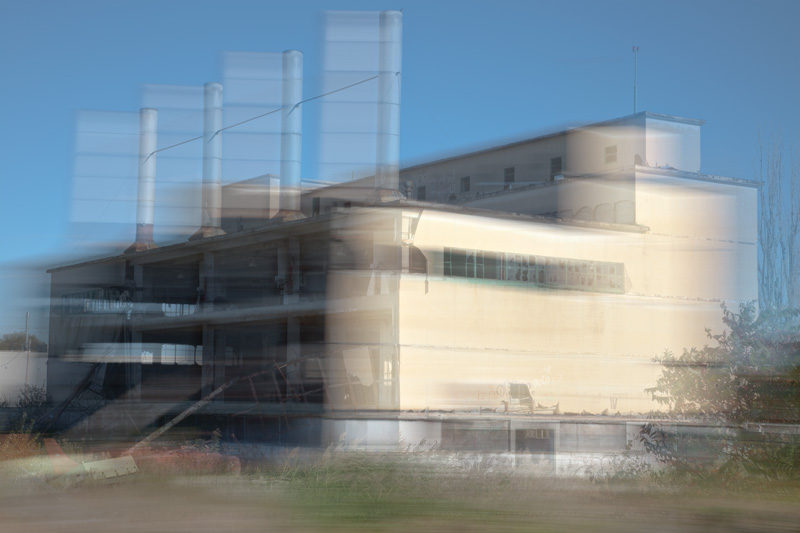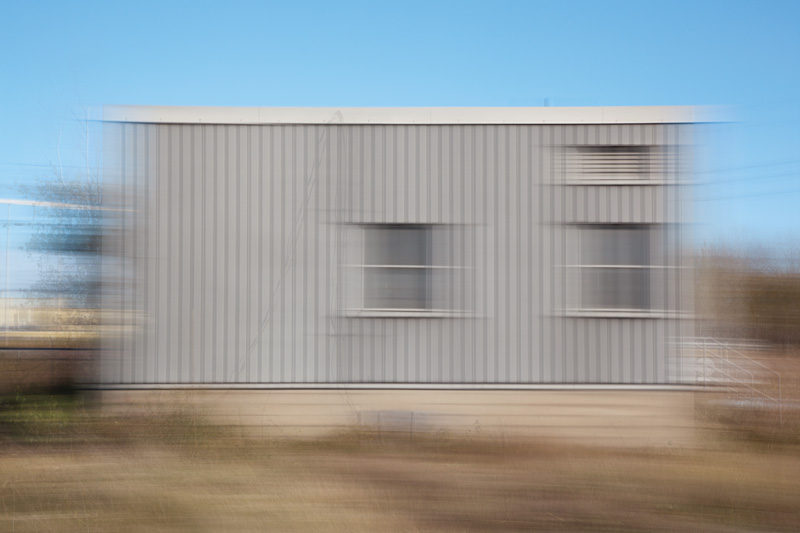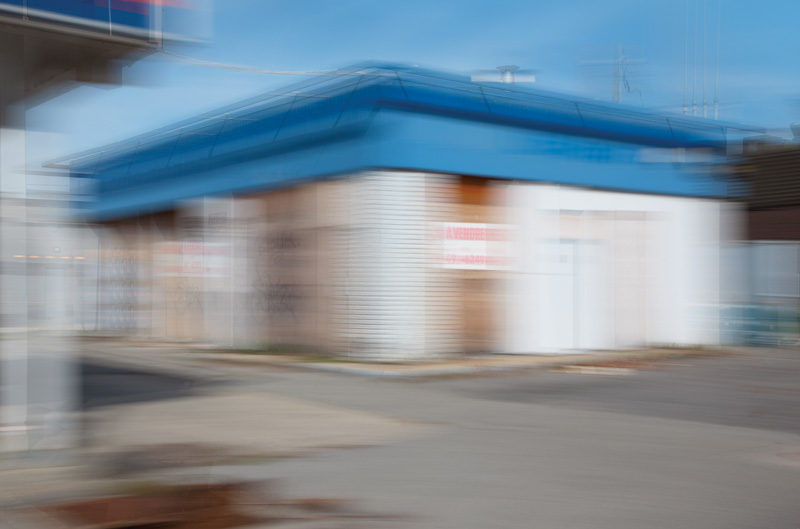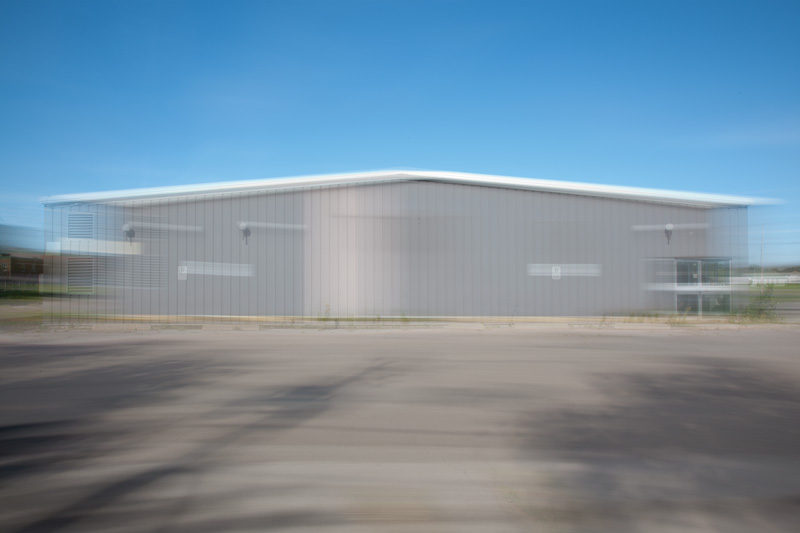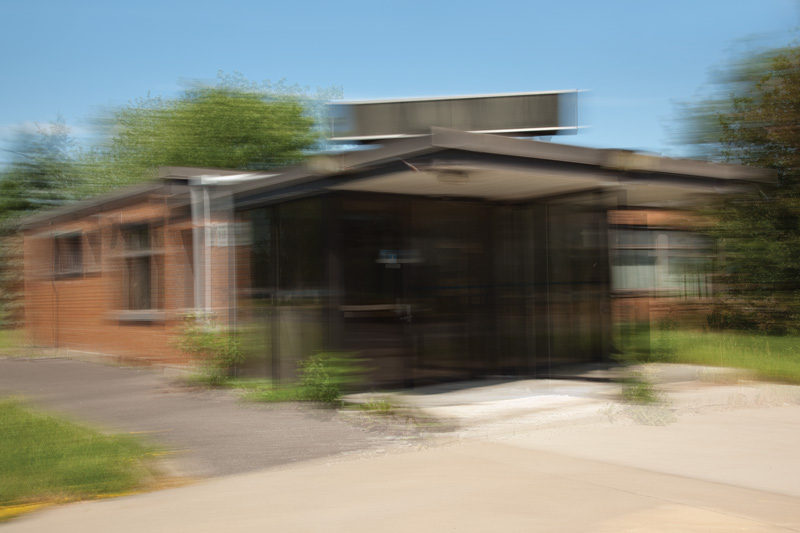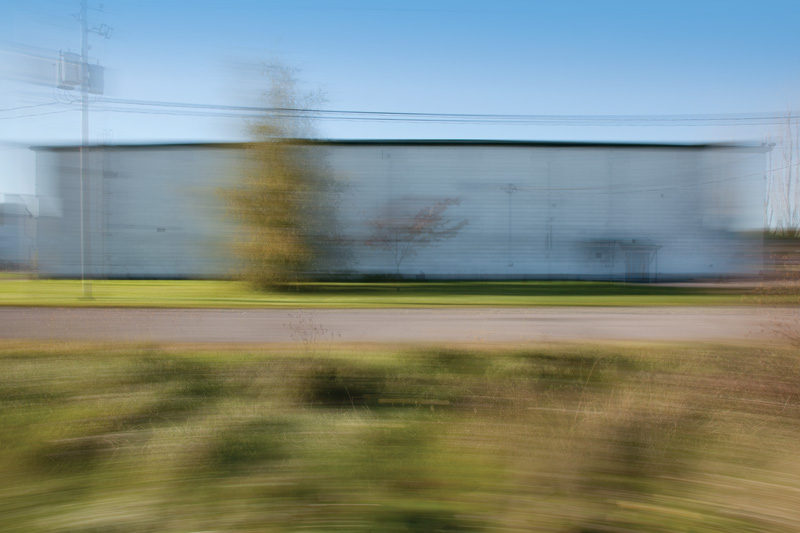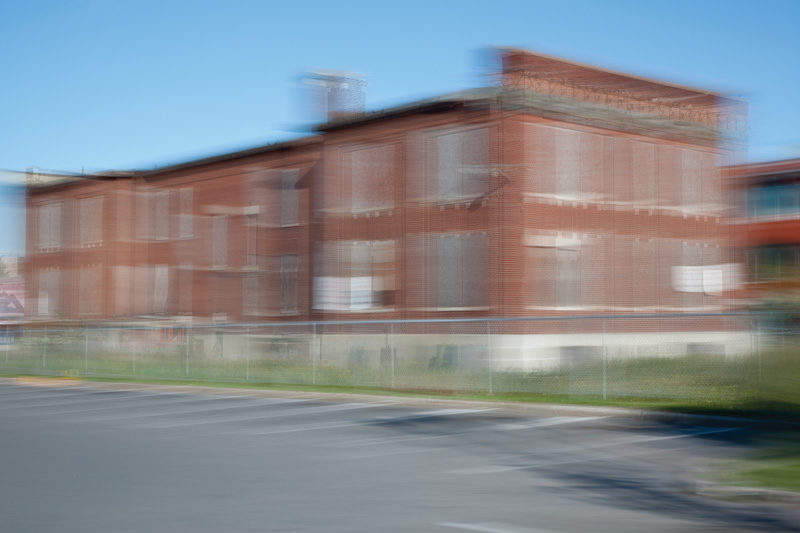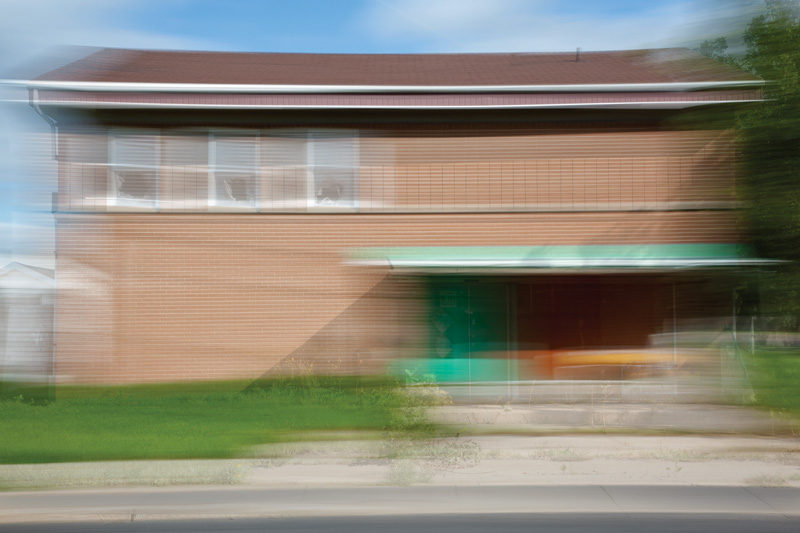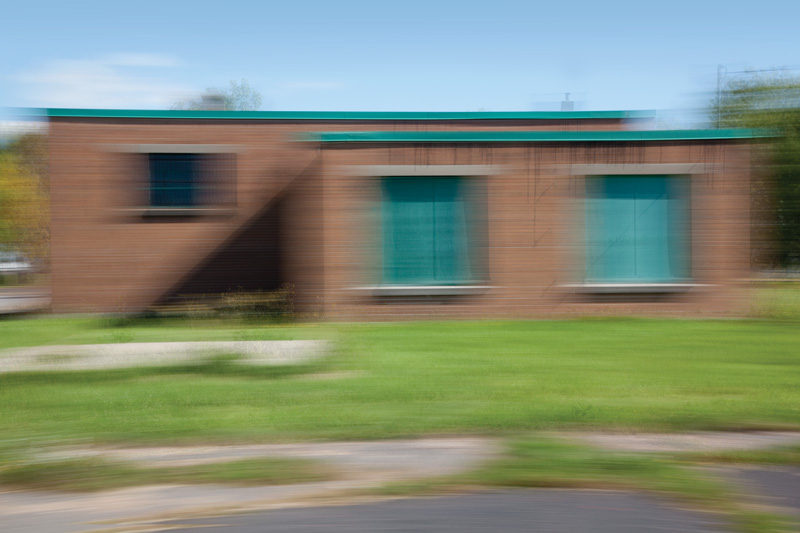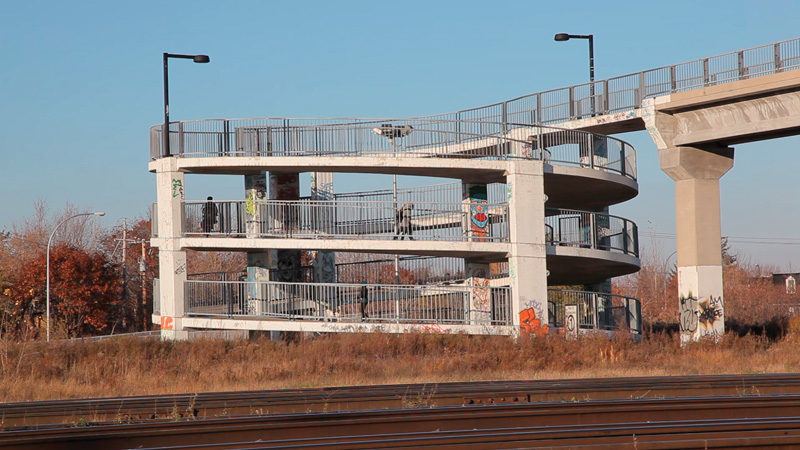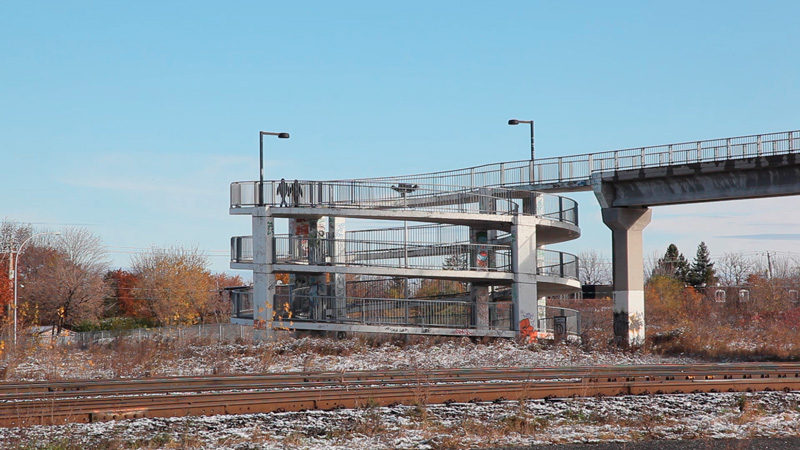[Fall 2011]
by René Viau
What do we see? Somewhere on the urban periphery, a parallelepiped of concrete topped with an azure tarp sits on a rectangle of asphalt. Elsewhere, the whitewashed wall of a shed rises behind a section of suspended electrical wires.
We come upon other indeterminate pieces of land, other uninhabited buildings. The photographs’ titles correspond to the toponymy of industrial sectors that appear more or less abandoned: Rue de l’Aviation, Boulevard Industriel. Traversing what urban planners call “poorly structured zones,” we are on the edges of a globalized suburbia. No trace of human activity. No cars. And absolutely no pedestrians.
Sylvie Readman’s recently exhibited new series À contretemps brings together ten of these architectural views. Each photograph shows a single building, presented frontally or at a forty-five-degree angle. This angle, in a tight shot, isolates the building, extracting it from the urban context. All of these shots were taken, systematically, at the same distance with the same framing, focus, and depth of field. In this first step, the images are very readable. In the second step, Readman took ten images of the same subjects, this time with a slow shutter speed and a long hand-held pan, simulating a sort of horizontal movement. The final step consisted of superimposing one shot (blurred) over the other (in focus). As the images are merged, we see both the clear, in-depth details and the out-of-focus effects of surface slippage and flow.
Oscillations and overprintings decompose and reinterpret these architectural elements. The images shimmer. The mitigated impressions of appearance and disappearance are maintained in suspension. In these recent photographs, Readman introduces colour. The image’s imprecise contours seem to retract and disgorge a surplus of colouring, almost too garish, to situate this inexact pattern within a duller softness. When we look at these views, the effect of interference blurs our reference points. There is a continuity between the subject that seems to bring out – between the banality of the buildings and the process that confers an echo upon these images – an ability for them to repeat and dissolve into themselves.
Traversing what urban planners call “poorly structured zones,” we are on the edges of a globalized suburbia. No trace of human activity. No cars. And absolutely no pedestrians.
Both fascinating and deceptive, these images are read as photographs that no doubt owe their physical and chemical existence to the incontrovertible clues to what they are showing, to what has been printed on their sensitive surface. At the same time, they are deciphered as multi-shaped tracings in the vagueness and mystery that bring them to life. What is imprinted on their surface, the instantaneousness that is so easily captured, is here weakened, shaken, rocked by vibrant superimpositions. The multiplied movements introduce tremors of doubt. With a core of unique, undefined beauty, these photographs lead to the irresolute border between the blurred and the “representable.” Tension is created – a tension that concerns both what, for better or worse, is fixed through these destabilized sites and the shuddering of the photographic procedure recording them. To find any reference point is difficult. The images of these disused, ghostly buildings seem to elude us as much as to deliver their fleeting clues. This uncertainty leads us to seek and re-create “traceability.” Sampling the clues, we must reconstruct what these images might conceal.
The use of colour in a dissolve effect and the proximity of these subjects with the theme of urban solitude were exploited in art of the 1930s. We sense a closeness between these photographs and the pictorial realism typical of that era; we feel a similar sense of strangeness. There is the impression of time momentarily arrested, as there is in an Edward Hopper painting. This affinity may be read as a way of bringing a pictorial tradition sometimes considered obsolete back to currency by including in the photograph a form of the melancholy attached to the pictorial medium.
But pictoriality is only one of the references to the past expressed. In Readman’s works, the architectural forms are reduced to a strictly functional instrumentality. This geometry dovetails with a certain lexicon of abstraction. The formal simplicity of her vocabulary could assert a claim to the precepts of functionalism, precepts that recall the triumphal phase of early architectural modernism arising from constructivism, today discredited. Here, in Chemin de la Savane, a warehouse isolated in a deserted parking lot has a metallic envelope that is reminiscent of certain more prestigious modernist structures. There, a Bauhaus influence can be discerned in a brick building with boarded-up windows surrounded by chain-link fencing. The built environment of a disused cement plant in a vacant lot is evocative of Le Corbusier’s concrete “ski jump” in Ronchamp, with its brutalist rigour. The experience of these sites is brought to us through a montage like a recomposed serialized suite. From one photograph to another, we assemble the puzzle to apprehend, amid the chaos, a certain order of things. This order is related to the kind of organization in a formal program attached to a certain type of utopia. In these structures, we decode how the index of the precise ideological program that intersects with these common production buildings would be assimilated and absorbed. The images also flush out the inscription in social reality of the idea of the formal absolute.
Such disaggregated subjects are held up as improbable evidence of a form of industrialization and of economic or technical activity that is no longer underway. This suspension of the subject outside of history is displayed by the disappearance of an architectural ideal, the purist modernism of the 1930s. In these images, Readman uncovers the remains of this lost model. Photography creates a paradoxical comparison. We see both the condition flowing from the model, linked to a form of artistic utopia that is revealed, and the condition of the non-place – this, even as the image dissolves and is reconstructed in interstice and diffraction.
The act of sabotage – showing that the unity of this utopian model subsists –brings to light the lapse in its collective (for all) and future dimensions. These abandoned buildings are linked to an “ordinary” vision of ruin, trivialized and repeated every day. It is as if utopia were condemned to produce its opposite; we are shown the flip side of the program – its decline. Photography becomes the observation, measured by the yardstick of time, of the distancing and loss of an ideal. This is not nostalgia but a contemporary reprise of the theme of melancholy. It is a little like Dürer’s famous etching Melencolia I, which depicts the attri-butes of artistic work, the melancholy melding with the erosion of an artistic ideal in its struggle to escape time, ungraspable.
This state of disappearance is accentuated through superimposition, lack of focus, and distancing, which can also be interpreted as a certain metaphoric patina. Just like what they allow us to see, these images, threatened and corroded by the processing that animates them, undergo long, brooding, successive corrections, leading, in the process being altered and bruised, to the risk of their end.
Translated by Käthe Roth
à voir un document vidéo enrichissant la thématique de cette artiste. Une trame sonore intégrant le bruit des réseaux ferroviaires nous parvient comme une incantation. Le document montre les passagers d’une gare de banlieue franchissant une rampe hélicoïdale et une passerelle métallique au-dessus des rails. L’accent se place sur l’enregistrement des flux et des circu-lations. L’atmosphère qui se dégage de ces lieux et de ce paysage banlieusard rejoint celle de bâtiments de la série À contretemps.
Sylvie Readman’s works often combine landscape views with effects of movement, overprinting, and fragmentation that help to distance the image. Readman has been involved in photography since the mid-1980s and has had shows regularly in Canada and abroad. Her work has been featured in “Femmes artistes du XXe siècle” (Quebec City, 2010) and two solo exhibitions, “De souffle et de suie” (Saint-Hyacinthe) and “Déploiements” (Longueuil), mounted in 2006. The winner of the Prix Graff in 2000, Readman is represented by Galerie Laroche-Joncas (Montreal). She lives and works in Montreal, where she has been teaching at UQAM’s School of Visual and Media Arts since 1999.
René Viau is a journalist and art critic. He has contributed to numerous publications and dailies in France and Quebec. He has written a number of books on Quebec artists.

